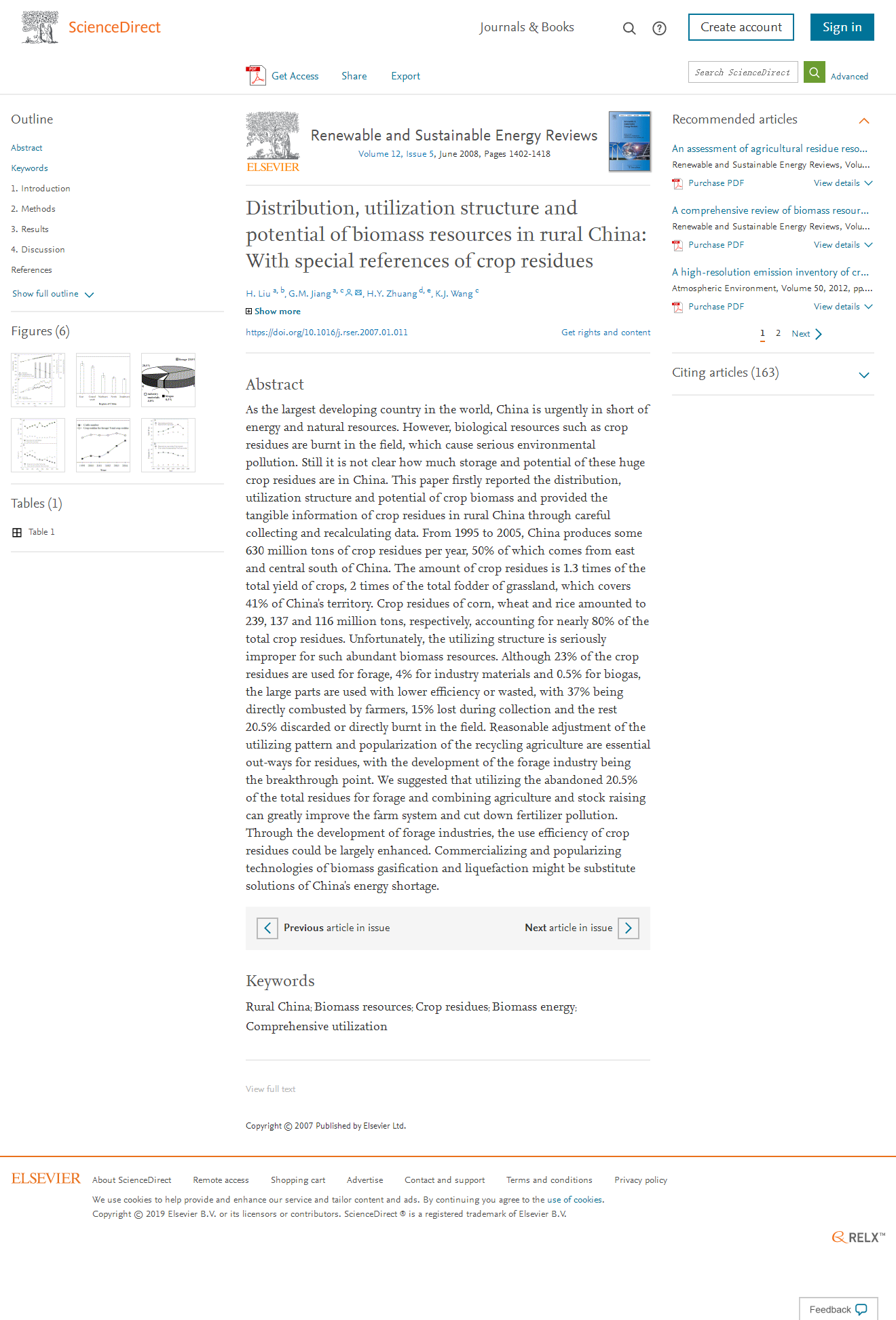博文
中国农村生物质资源分布、结构与应用潜力:以农作物秸秆为例
|||
中国农村生物质资源分布、结构与应用潜力:以农作物秸秆为例
刘慧、蒋高明、庄会永、王空军
(中国科学院植物研究所植被与环境变化国家重点实验室,北京100093)
蒋高明为本文通讯作者,本文发表后SCI引用238次
Renewable and Sustainable Energy Reviews, 12: 1402-1408
(影响因子:11.239)
中国作为世界上最大的发展中国家,能源和自然资源紧缺。然而,农作物秸秆等生物资源在田间被焚烧,造成了严重的环境污染问题。目前,尚不清楚这些巨大的农作物残留物在中国有多大的储藏量和潜力。本文首次报道了中国农村农作物生物量的分布、结构和应用潜力,通过认真收集和重新计算数据,提供了中国农村农作物秸秆的具体信息。从1995年到2005年,中国每年产生约6.3亿吨农作物秸秆,其中50%来自中国东部和中南部。农作物残留量是农作物总产量的1.3倍,是草地饲料总量的2倍,而草地占全国国土面积的41%。玉米、小麦和水稻的作物秸秆分别为239,137和1.16亿吨,占作物秸秆总量近80%。遗憾的是,这些丰富的生物质资源利用结构严重不合理。虽然农作物秸秆23%用于饲料,4%用于工业原料,0.5%用于沼气,但大部分应用低效或浪费,其中37%由农户直接燃烧,15%在收集过程中损失,其余20.5%丢弃或直接在田间焚烧。合理调整秸秆利用方式,推广循环农业,是秸秆资源化利用的必由之路,而发展秸秆饲料工业是突破口。将废弃秸秆作为饲料,农牧结合,可大大改善农作系统,减少化学肥料污染。通过发展饲料工业,可以大大提高农作物秸秆利用效率。除此之外,生物质气化、液化技术的商业化推广可能是解决中国能源短缺的替代方案之一。
关键词:中国农村,生物质资源,农作物秸秆,生物质能源,综合利用
Distribution, utilization structure and potential of biomass resources in rural China: with special references of crop residues
H. Liu, G. M. Jiang, H.Y. Zhuang, K.J.Wang
(Institute of Botan, Chinese Academy of Sciences, Beijing 100093)
Renewable and Sustainable Energy Reviews, 12: 1402-1408 (IF=11.239)
As the largest developing country in the world, China is urgently in short of energy and natural resources. However, biological resources such as crop residues are burnt in the field, which cause serious environmental pollution. Still it is not clear how much storage and potential of these huge crop residues are in China. This paper firstly reported the distribution, utilization structure and potential of crop biomass and provided the tangible information of crop residues in rural China through careful collecting and recalculating data. From 1995 to 2005, China produces some 630 million tons of crop residues per year, 50% of which comes from east and central south of China. The amount of crop residues is 1.3 times of the total yield of crops, 2 times of the total fodder of grassland, which covers 41% of China's territory. Crop residues of corn, wheat and rice amounted to 239, 137 and 116 million tons, respectively, accounting for nearly 80% of the total crop residues. Unfortunately, the utilizing structure is seriously improper for such abundant biomass resources. Although 23% of the crop residues are used for forage, 4% for industry materials and 0.5% for biogas, the large parts are used with lower efficiency or wasted, with 37% being directly combusted by farmers, 15% lost during collection and the rest 20.5% discarded or directly burnt in the field. Reasonable adjustment of the utilizing pattern and popularization of the recycling agriculture are essential out-ways for residues, with the development of the forage industry being the breakthrough point. We suggested that utilizing the abandoned 20.5% of the total residues for forage and combining agriculture and stock raising can greatly improve the farm system and cut down fertilizer pollution. Through the development of forage industries, the use efficiency of crop residues could be largely enhanced. Commercializing and popularizing technologies of biomass gasification and liquefaction might be substitute solutions of China's energy shortage.
Keywords: Rural China, Biomass resources, Crop residues, Biomass energy, Comprehensive utilization


https://wap.sciencenet.cn/blog-475-1204331.html
上一篇:《中国大百科全书》新增词条:生态农场
下一篇:美国环保署、江苏省农科院专家考察参观弘毅生态农场